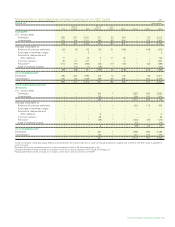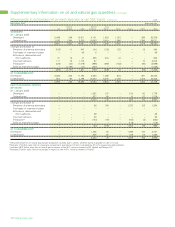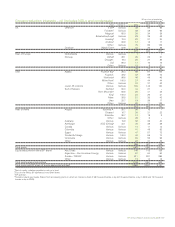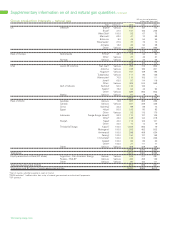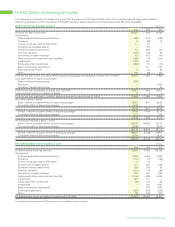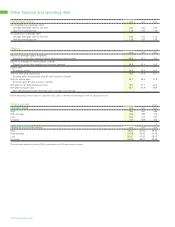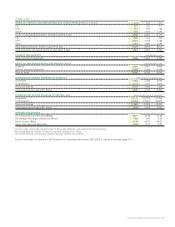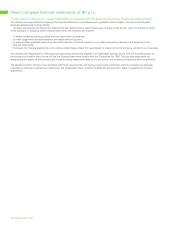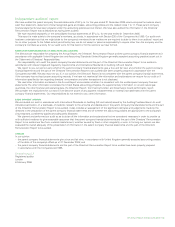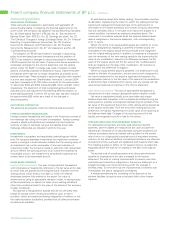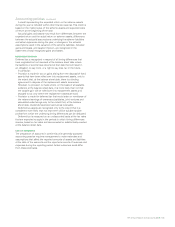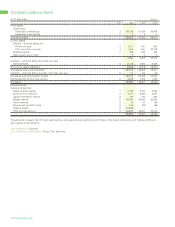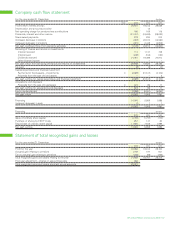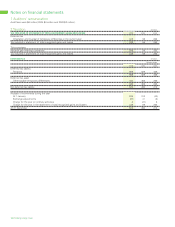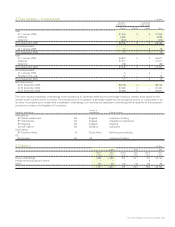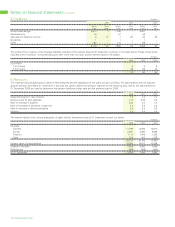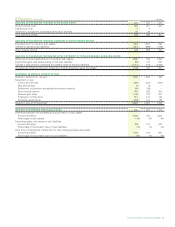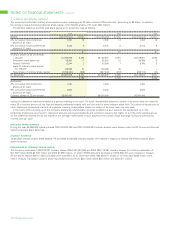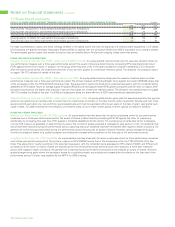BP 2005 Annual Report Download - page 146
Download and view the complete annual report
Please find page 146 of the 2005 BP annual report below. You can navigate through the pages in the report by either clicking on the pages listed below, or by using the keyword search tool below to find specific information within the annual report.
144 Making energy more
Parent company financial statements of BP p.l.c. continued
Accounting policies
ACCOUNTING STANDARDS
These accounts are prepared in accordance with applicable UK
accounting standards. In preparing the financial statements for the
current year, the company has adopted Financial Reporting Standards
No. 20 ‘Share-based Payment’ (FRS 20), No. 21 ‘Events after the
Balance Sheet Date’ (FRS 21), No. 22 ‘Earnings per share’, No. 23
‘The Effects of Changes in Foreign Exchange Rates’, No. 24 ‘Financial
Reporting in Hyperinflationary Economies’, No. 25 ‘Financial
Instruments: Disclosure and Presentation’, No. 26 ‘Financial
Instruments: Measurement’, No. 27 ‘Life Assurance’ and No. 28
‘Corresponding Amounts’.
The adoption of FRS 20 has resulted in changes in accounting
policy for share-based payment transactions and the adoption of
FRS 21 has resulted in changes in accounting policy for dividends.
FRS 20 requires that the fair value of options and shares awarded to
employees is charged to the income statement over the vesting
period. Under UK GAAP, no charge was made in respect of share
options. Dividends proposed or declared on equity instruments after
the balance sheet date are no longer recognized as a liability at the
balance sheet date. These changes in accounting policy have resulted
in a prior year adjustment. Shareholders’ interest at 1 January 2004
has been increased by $1,750 million and profit for the years ended
31 December 2004 and 2003 reduced by $64 million and $47 million
respectively. The statement of total recognized gains and losses
includes a prior year adjustment representing deferred taxation on
share-based payments. Profit for the current year has been reduced
by approximately $86 million as a result of the changes in
accounting policy.
ACCOUNTING CONVENTION
The accounts are prepared under the historical cost convention.
FOREIGN CURRENCY TRANSACTIONS
Foreign currency transactions are booked in the functional currency at
the exchange rate ruling on the date of transaction. Foreign currency
monetary assets and liabilities are translated into the functional
currency at rates of exchange ruling at the balance sheet date.
Exchange differences are included in profit for the year.
INVESTMENTS
Investments in subsidiary and associated undertakings are held at
cost. The company assesses investments for impairment whenever
events or changes in circumstances indicate that the carrying value of
an investment may not be recoverable. If any such indication of
impairment exists, the company makes an estimate of its recoverable
amount. Where the carrying amount of an investment exceeds its
recoverable amount, the investment is considered impaired and is
written down to its recoverable amount.
SHARE-BASED PAYMENTS
Equity-settled transactions The cost of equity-settled transactions
with employees is measured by reference to the fair value at the date
at which they are granted and is recognized as an expense over the
vesting period, which ends on the date on which the relevant
employees become fully entitled to the award. Fair value is
determined by using an appropriate valuation model. In valuing equity-
settled transactions, no account is taken of any vesting conditions
other than conditions linked to the price of the shares of the company
(market conditions).
No expense is recognized for awards that do not ultimately vest,
except for awards where vesting is conditional upon a market
condition, which are treated as vesting irrespective of whether or not
the market condition is satisfied, provided that all other performance
conditions are satisfied.
At each balance sheet date before vesting, the cumulative expense
is calculated, representing the extent to which the vesting period has
expired and management’s best estimate of the achievement or
otherwise of non-market conditions and number of equity instruments
that will ultimately vest or in the case of an instrument subject to a
market condition, be treated as vesting as described above. The
movement in cumulative expense since the previous balance sheet
date is recognized in the income statement, with a corresponding
entry in equity.
Where the terms of an equity-settled award are modified or a new
award is designated as replacing a cancelled or settled award, the
cost based on the original award terms continues to be recognized
over the original vesting period. In addition, an expense is recognized
over the remainder of the new vesting period for the incremental fair
value of any modification, based on the difference between the fair
value of the original award and the fair value of the modified award,
both as measured on the date of the modification. No reduction is
recognized if this difference is negative.
Where an equity-settled award is cancelled, it is treated as if it had
vested on the date of cancellation, and any cost not yet recognized in
the income statement for the award is expensed immediately. Any
compensation paid up to the fair value of the award at the cancellation
or settlement date is deducted from equity, with any excess over fair
value being treated as an expense in the income statement.
Cash-settled transactions The cost of cash-settled transactions is
measured at fair value using an appropriate option valuation model.
Fair value is established initially at the grant date and at each
balance sheet date thereafter until the awards are settled. During the
vesting period, a liability is recognized representing the product of the
fair value of the award and the portion of the vesting period expired as
at the balance sheet date. From the end of the vesting period until
settlement, the liability represents the full fair value of the award as at
the balance sheet date. Changes in the carrying amount for the
liability are recognized in profit or loss for the period.
PENSIONS AND OTHER POST-RETIREMENT BENEFITS
For defined benefit pension and other post-retirement benefit
schemes, scheme assets are measured at fair value and scheme
liabilities are measured on an actuarial basis using the projected unit
method and discounted at an interest rate equivalent to the current
rate of return on a high-quality corporate bond of equivalent currency
and term to the scheme liabilities. Full actuarial valuations are obtained
at least every three years and are updated at each balance sheet date.
The resulting surplus or deficit, net of taxation thereon, is presented
separately above the total for net assets on the face of the balance
sheet.
The service cost of providing pension and other post-retirement
benefits to employees for the year is charged to the income
statement. The cost of making improvements to pension and other
post-retirement benefits is recognized in the income statement on a
straight-line basis over the period during which the increase in
benefits vests. To the extent that the improvements in benefits vest
immediately, the cost is recognized immediately.
A charge representing the unwinding of the discount on the
scheme liabilities during the year is included within other finance
expense.



